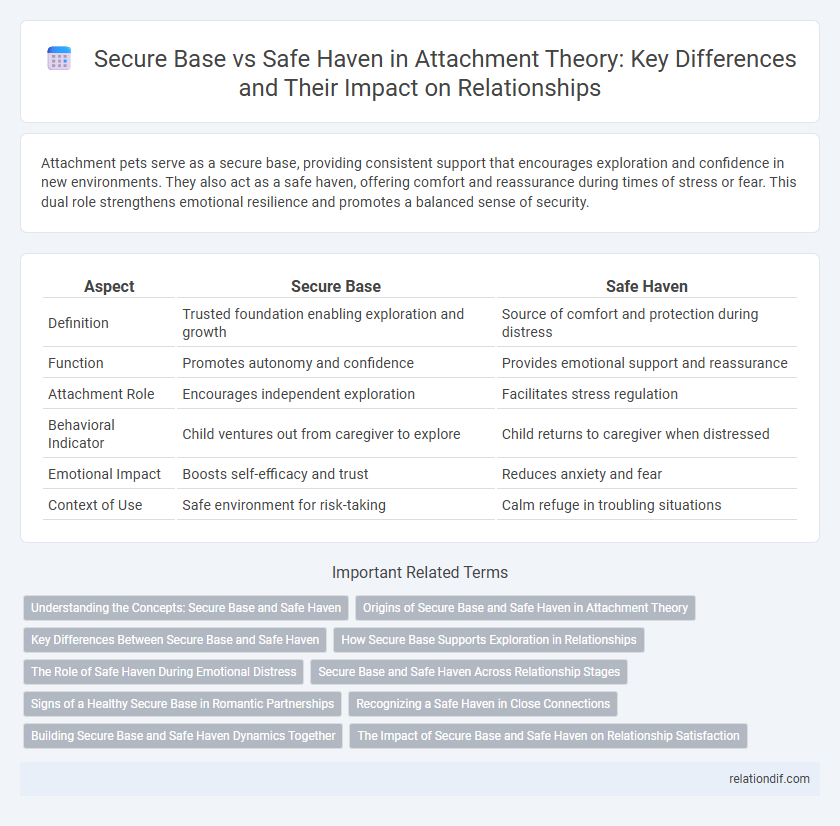Attachment pets serve as a secure base, providing consistent support that encourages exploration and confidence in new environments. They also act as a safe haven, offering comfort and reassurance during times of stress or fear. This dual role strengthens emotional resilience and promotes a balanced sense of security.
Table of Comparison
| Aspect | Secure Base | Safe Haven |
|---|---|---|
| Definition | Trusted foundation enabling exploration and growth | Source of comfort and protection during distress |
| Function | Promotes autonomy and confidence | Provides emotional support and reassurance |
| Attachment Role | Encourages independent exploration | Facilitates stress regulation |
| Behavioral Indicator | Child ventures out from caregiver to explore | Child returns to caregiver when distressed |
| Emotional Impact | Boosts self-efficacy and trust | Reduces anxiety and fear |
| Context of Use | Safe environment for risk-taking | Calm refuge in troubling situations |
Understanding the Concepts: Secure Base and Safe Haven
A secure base refers to the attachment figure's role in providing a reliable foundation that encourages exploration and confidence, enabling an individual to engage with their environment while knowing support is available. A safe haven emphasizes the attachment figure as a source of comfort and protection during times of stress or threat, facilitating regulation of emotions and recovery from distress. Distinguishing between secure base and safe haven enhances understanding of attachment dynamics and their impact on emotional development and interpersonal relationships.
Origins of Secure Base and Safe Haven in Attachment Theory
The origins of secure base and safe haven concepts in attachment theory trace back to John Bowlby's foundational work emphasizing the caregiver's dual role in providing a reliable platform for exploration (secure base) and a comforting refuge during distress (safe haven). These functions are rooted in evolutionary survival mechanisms, where the caregiver's presence ensures both safety for risk-taking and emotional regulation during threats. Mary Ainsworth's empirical studies further operationalized these ideas, highlighting patterns of secure attachment behaviors that balance autonomy with the need for protection.
Key Differences Between Secure Base and Safe Haven
A secure base refers to a caregiver's role in promoting exploration and confidence, providing a foundation from which individuals can venture out to learn and grow. In contrast, a safe haven offers immediate comfort and protection during times of distress or threat, emphasizing emotional support and reassurance. The key difference lies in the secure base enabling autonomy and exploration, while the safe haven focuses on offering refuge and alleviating fear or anxiety.
How Secure Base Supports Exploration in Relationships
A secure base in attachment theory provides emotional support and confidence that encourages individuals to explore their environment and take risks within relationships. This foundation fosters autonomy by assuring the presence of a reliable partner who offers comfort when needed, promoting growth and resilience. Exploration thrives when individuals trust their secure base, knowing they can return for safety and validation.
The Role of Safe Haven During Emotional Distress
The safe haven functions as a critical source of comfort and reassurance during times of emotional distress, allowing individuals to seek support and reduce anxiety by turning to their attachment figures. This mechanism helps regulate intense emotions and fosters a sense of security necessary for emotional recovery. Secure base and safe haven are complementary components in attachment theory, where the safe haven specifically addresses immediate emotional needs during stress.
Secure Base and Safe Haven Across Relationship Stages
Secure base and safe haven serve distinct roles across relationship stages, with the secure base promoting exploration and growth by providing confidence and support, particularly in early relationship phases. The safe haven offers comfort and reassurance during times of stress or distress, becoming increasingly vital as relationships deepen and face challenges. Together, these attachment functions ensure emotional stability and resilience, adapting to evolving relational demands over time.
Signs of a Healthy Secure Base in Romantic Partnerships
Healthy secure bases in romantic partnerships manifest through consistent support and encouragement for personal growth, reflecting emotional availability and reliability. Partners demonstrate trustworthiness by respecting boundaries and fostering independence while maintaining emotional connection. Clear communication, responsiveness to needs, and mutual respect serve as core indicators of a secure base, enhancing relationship stability and intimacy.
Recognizing a Safe Haven in Close Connections
Recognizing a safe haven in close connections involves identifying individuals who provide comfort and emotional support during times of distress. Unlike a secure base that encourages exploration, a safe haven offers reassurance and refuge, helping to regulate emotions and restore a sense of security. Key indicators include empathetic listening, consistent availability, and nonjudgmental responses that foster trust and emotional healing.
Building Secure Base and Safe Haven Dynamics Together
Building a secure base involves fostering a reliable presence that encourages exploration and growth, while safe haven dynamics emphasize emotional support and comfort during distress. Integrating secure base and safe haven elements strengthens attachment by balancing autonomy with reassurance, promoting resilience and trust in relationships. Effective attachment relationships synchronize these dynamics to support both independence and emotional security.
The Impact of Secure Base and Safe Haven on Relationship Satisfaction
A secure base fosters relationship satisfaction by encouraging individual growth and exploration while maintaining emotional support, enhancing trust and confidence between partners. A safe haven provides comfort and reassurance during times of stress, promoting emotional regulation and deepening intimacy. Both secure base and safe haven dynamics contribute to higher relationship satisfaction through balanced autonomy and emotional closeness.
Secure base vs safe haven Infographic

 relationdif.com
relationdif.com